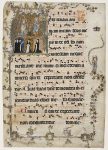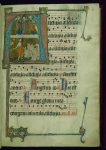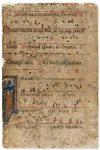Netherlandish illuminated manuscript on parchment. Opening leaf from a Dominican Gradual with historiated initial ‘A’ depicting Annunciation with two angels playing musical instruments. In the outer margin an angel holds a scroll bearing a Latin inscription, ‘gift of Katerina of Gouda and Maria Ursi, nuns’. Around the borders of the page are birds, a butterfly and grotesque figures.
This is a page from a Gradual. The Gradual contained the musical parts of the Missal, the book containing the services of the Mass. The initial A is historiated (that is, with a figurative picture, istoire being the term for a story). It shows the Annunciation, in which the Angel Gabriel was sent to the Virgin Mary to announce the birth of Jesus Christ. In the outer margin an angel holds a scroll bearing an inscription, ‘gift of Katerina of Gouda and Maria Ursi, nuns’. Around the borders of the page are birds, a butterfly and grotesque figures.
From the last decades of the 13th century, it was common for the ornament that framed the text to be inhabited by regiments of grotesque figures. These were half-man and half-beast. They were depicted alongside animals and birds that were realistically represented. Interspersed among the birds and animals were dragons’ bodies and grotesque faces. Occasionally, there is a link between the grotesques and the text, but often there seems little more than incongruous romping. This choirbook was made for a community of Dominican nuns. Female grotesques playing musical instruments are shown under the praying figures of the nuns.
Reference: © Victoria and Albert Museum
Musician Angels and the Harrowing of Hell
1290 (Medieval) ink, paint, and gold on parchment
Reference: The Walters Art Museum
Christ in Gethsemane.- Leaf from an Illuminated Latin Choirbook, illuminated manuscript on parchment, in Latin, 8 lines of text with music on a 4-line stave, enclosing on one side a large illuminated initial ‘I’ (opening: ‘In monte oliveti ora’) in pink and blue, enclosing Christ kneeling in prayer in Gethsemane, large initials in red or blue with contrasting penwork, rubrics in red, fine penwork flower heads touched in red used as line-fillers, somewhat scuffed and damaged in places, minor repairs to upper and inner margins, slightly affecting text and left edge of illuminated initial, 395 x 260 mm., Northern Italy or perhaps southern France, last decades of 13th century. ⁂ A complete leaf from a Latin choirbook, bearing a fine illuminated initial relating to the responsory for the first nocturn on Maundy Thursday. The large initial includes an arch at the top, and shows Christ in Gethsemane, kneeling in a hilly landscape with foliage with hands raised in fervent prayer, before a deep blue sky. Christ is wearing orange robes, and his white-painted face is expressive, revealing the work of a skilled artist.
Sold for £480 at Forum Auctions in 2017


